The Children’s Crusade in Greta and the Giants
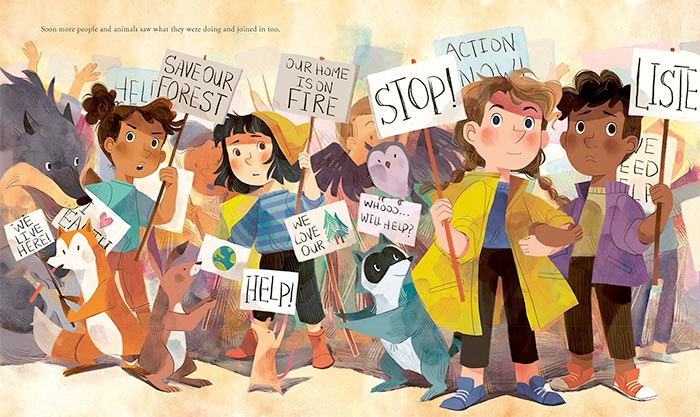
In 2019, a year after Greta Thunberg’s first strike outside the Swedish Riksdag (parliament), Greta and the Giants was released, inspired by her story. The children’s book details the resistance of a young girl to environmental destruction caused by ‘giants’. It is an interesting, and very cleverly placed advocate for the children’s crusade and environmental alarmism.
To understand what it means with “children’s crusade”, we must first explore environment alarmism. This brings us then to Michael Shellenberger and his confession to the world.
On the 2nd of July 2020, The Australian released an article detailing Michael Shellenberger’s confession and apology to the world. The article, written by Shellenberger himself explains the concepts of his new non-fiction book Apocalypse Never, which focuses on the effect of environmental alarmism.
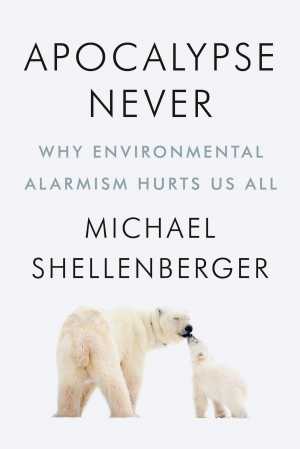
Apocalypse Never outlines that environmental alarmism hurts us all and does not help our situation. Shellenberger says that “climate change is real, but it’s not the end of the world. It is not even our most serious environmental problem.”
Most environmental trends, including population, pollution, and resource use, are all going in the right direction. Shellenberger presents facts like: fires have declined 25 per cent around the world since 2003; habitat loss and the direct killing of wild animals are bigger threats to species than climate change; Wood fuel is far worse for people and wildlife than fossil fuels; preventing future pandemics requires more, not less, “industrial” agriculture; and the amount of land we use for meat — humankind’s biggest use of land — has declined by an area nearly as large as Alaska.
In opposition then to climate change being the most serious environment problem, as alarmists claim, he suggests that “poverty, not prosperity, is the real enemy of the environment.” In agreement with this, then is his statement that environmental alarmism profits the left, as he suggests that they are opposing obvious and easy solutions in order to profit more. An example he gives is “The Green New Deal” which, he says, will “transfer wealth to well-connected elites, raise energy costs, and hurt wildlife.”
The Green New Deal is a congressional initiative and resolution in America that seeks to curb planet-warming greenhouse gas emissions and wean fossil fuel usage out of the United States. Furthermore, it will create higher paying positions in clean energy and energy-saving industries.
Taking this then to Greta and the Giants we can then see the hypocrisy of the book. We will connect environmental alarmism and its effects, which create uninformed decisions and chaos, to the text, delving further into what is also called the “children’s crusade”.
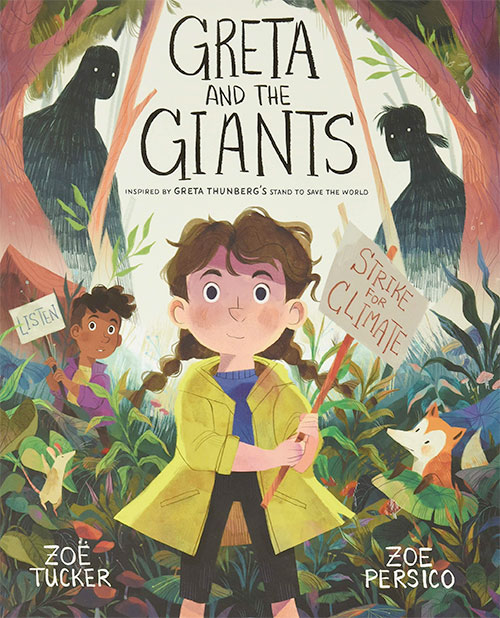
The “children’s crusade” can be easily defined as the over appealing of parental concern for the welfare of their children. Huebner and Chilton say that,
Nowhere is parental concern for the welfare of their children more regularly appealed to than in the area of environmental protection.
They finish their article along the same lines as Shellenberger suggesting that “rather than using children’s health as a rhetorical weapon in regulatory debates, we should publicise the proven dangers to children and promote the actions that we know can make a difference.” These two agree with Shellenberger when he says that environmental alarmism profits the left.
Their suggestion is that people would rather focus on debating about these issues than looking for real answers, because the debate creates revenue and opportunities where profit can be made.
The dangers to our children have been proven, so why aren’t we fixing them? Why aren’t we tackling poverty properly; and what about malnutrition in third world countries; and racism which causes dissent and unrest? These are the major problems that we can fix, climate change will right itself, it always has.
Rather we focus on environmental alarmism and scare the world away from the real problems. Environmental alarmism, says Bjorn Lomborg,
…creates a lot of attention, but it rarely leads to intelligent solutions for real problems, something that requires calm consideration of the costs and benefits of various courses of action.”
He continues on by explaining that,
…implying the problems the world faces are so great and so urgent that they can be dealt with only by massive immediate interventions and sacrifices — which are usually politically impossible and hence never put into practice — environmental alarmism actually squelches debate over the more realistic interventions that could make a major difference.
So now that we have set up that framework of environmental alarmism and the children’s crusade, let us take a closer look at Greta and the Giants and see how it is a clear advocate for the children’s crusade and environmental alarmism.
First let us have a close look at the introduction of Greta (pg. 1-2). The first time we see Greta she is surrounded by animals, most of which are bigger than her, and beautiful green trees. A wonderful image is planted in our heads. The glow of the forest makes it seem heavenly, with the animals guarding our little protagonist, Greta. Did you notice how the light forms the shape of a heart with the girl in the middle? A real beating heart that complements the words on the page.
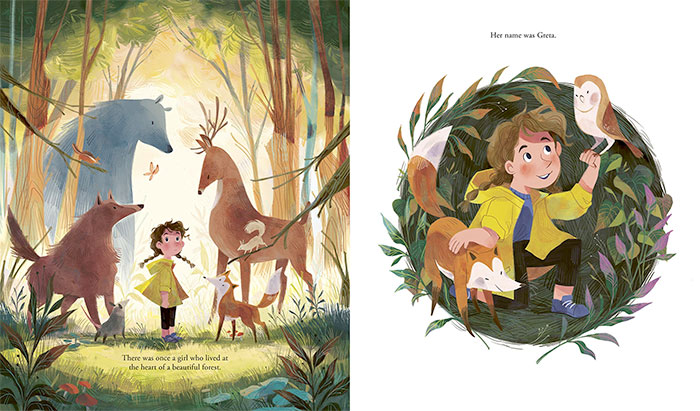
The next page introduces the girl as Greta. She is seen as a friend to the animals, with her hand stroking the fox, whilst gazing happily at the owl perched on her arm. The stark contrast of colours between this page and the previous one shows the shift of focus. Greta and her relationship with the animals, is the focus of this page.
This immediate shift from beautiful environment to focussing solely on Greta, shows her importance to the environment. It also implies her hero status toward the environment, and how she is immediately branded as the saviour of nature.
Now let us look at the hyperbolic contrast of the giants (pg. 5-6). The juxtaposition of size between the giants and the animals on page 5 is significant in the building of alarmism. As the animals and Greta are the protagonists, and the protectors of the environment, to contrast them with larger than life giants who destroy the environment creates alarm in readers. We fear for the animals, as these giants run through the forest, not caring where they stand.
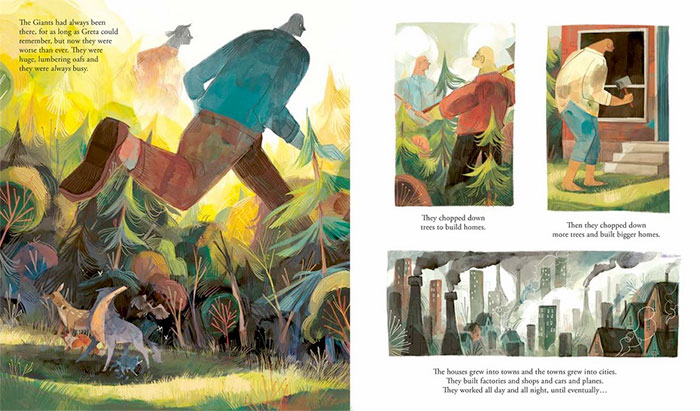
The lexical choice of “lumbering” creates a double meaning, and links to the next page. The giants are huge, stamping or lumbering oafs, but they are also lumberjacks who cut down the trees for houses and buildings. The connection there is too great to ignore, and quite cleverly portrayed. Through the use of that single word, the giants are portrayed as having a single purpose: to cut down the trees of the forest for building their houses.
This is solidified in the extrapolation on page 6, which describes that they do chop down trees to build houses, and then chop more down to build bigger houses. The way this is said implies that the cycle continues and will continue if someone doesn’t stop it. The tone of these pages then is clearly alarmist, as they work to hyperbolise the destruction of the forest.
The effect of this destruction is significantly enhanced when we remember the beauty of the forest. We remember how the forest was depicted in a heavenly glow, and therefore the destruction of it wrenches at our hearts.
Finally, we will analyse the depiction of the city on page 7. The city that the giants build is shown in its full ugly glory on page seven. There is smoke pouring out from many large chimneys, exaggerating the amount of pollution a city causes. The sky is darkened with smoke and pollutants. We can see zero bits of green in the city, which enhances the giants total disregard for the forest.
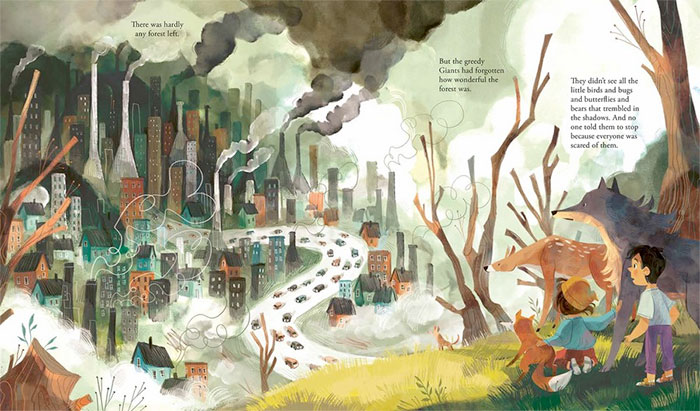
The entire city is shrouded with dark polluted smoke as an exaggeration of the dangers of large cities. The alarmism in this page is clearly evident, as the depiction of the city seems to be taken out of a dystopian world. A dystopian world where there is “hardly any forest left”, where the giants have destroyed the environment.
This harbinger of doom, this warning to the world is clearly evident in this page. The environmental alarmists are once again taking it too far, and exaggerating the damage that humans can cause on the environment.
Blown out of proportion, the destruction of the environment in this book is supposed to get us talking, wanting to help, and feeling scared for our children’s lives. We are forced to think that this is an almost surreal problem that must be dealt with.
But, how far does this alarmism make us go?
I say that it doesn’t get us far. All it does is strike fear in our hearts and start discussion about how terrible climate change and global warming are for this world. It gives entrance to broad statements like we should stop logging the Amazon; or we should reduce carbon emissions.
That does not get us far though does it? We need more. We need solutions, not broad statements, and we need solutions to the real problems that are more important than preserving the environment.
Greta and the Giants is not the only children’s book, or young adults’ book that does this. I think of Exodus by Julie Bertagna which uses global warming as a catalyst for a science fiction novel. Exodus is a story set on a small island that is faced with the problem of rising sea levels due to global warming. The scene in this novel is also set out to alarm the reader.
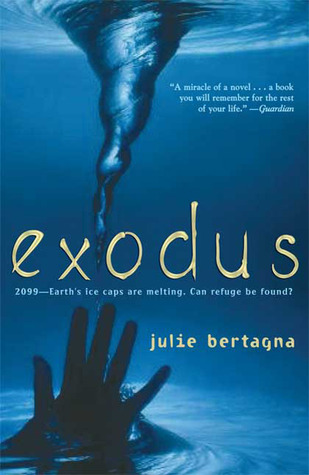
The Lonely Polar Bear by Khoa Le is another story that deals with global warming and climate change from an alarmist point of view. Describing the story of a young polar bear who loses his mother in a great storm, the story follows him as he makes friends in a world filled with climate change related dangers. The story takes on a different tack by appealing to the emotional side of young readers.
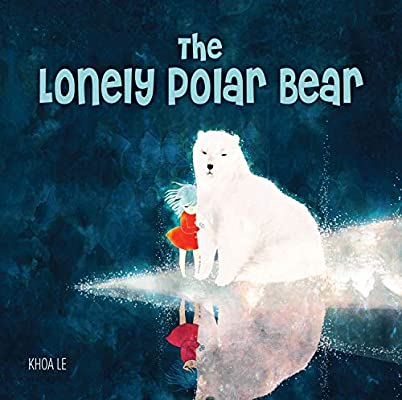
Do you feel alarmed by the destruction in Greta and the Giants? If you do, then great, because that is what they wanted.
What do you think? Leave a comment.











Good work. I love the way you incorporated illustrations from Greta and the Giants and went through the story in detail.
Let’s not be oversensitive to alarmism. Even with all the scientific, and literary alarmism going on it seems to have little effect compared with capitalist industrial and commercial greed. Gerry
This is such a great book to introduce kids, and even adults, to Greta Thunberg and her climate change protests.
It is a fable about environmental protection.
Blind capitalism and greet of humans is destroying environment to the extent that is directly coming to a situation where; whole biomass is at risk.
Everyone will suffer if earth wilts. Somebody had to take a lead and Greta did it.
This graphic novel is a perfect start for teaching little kids about environmental catastrophe. I bought it for my daughter.
The story is presented in such a way that even the youngest of children will intuit that this is a call to change.
Just read this together with my children last week. The book is superbly illustrated, and the evolution of the giants, from shadowy and highly imposing figures into friendly and approachable, albeit still large, entities is truly inspired.
Just finished reading this to my 3 year old and I wasn’t sure how he would react. I’m proud to say he felt very passionate about the poor animals and that the giants were bad.
I appreciate that there was no hate or anger in the book but utilized words such as sadness.
This is one of its highlights. This way my child and others won’t feel the powerful negativity of the situation at first but can slowly be introduced to the issues and not overwhelmed.
I liked how it took the seriousness of the climate change issue and presented it in a way that even my 4 year old can receive the message.
Greta and all of the worlds climate activists are amazing and instill so much hope for my children’s futures.
There is a clear distinction between Greta, her friends and then the giants on the other side, but without demonizing the latter. They’re just people who happen to be giants, and they’re so busy they don’t realise what they do. But they’re able to learn if someone is willing to teach them. Lovely stuff.
I think this is such an important topic right now and there’s absolutely no reason why children shouldn’t be given the opportunity to make a difference too. Greta in this story and in real life is an inspiration, and I hope this book inspires all readers to make small changes in their life to help tackle climate change.
I am all for telling stories about important girls and women, in order to bring them to light, to make their stories heard and important. But there is a downside to books that are ‘just ideological’, without the artistic, creative component, without the spark that can sometimes make the world a better and more imaginative place.
This is a definite book that should be in all schools. I think it would have more impact with children 8 and up.
When you have friends who die as a result of the increased temperatures, increased droughts, increased drying of the chaparral and forests, increased destabilized weather events, and consequent flooding – when that happens to you, as it has happened to me, maybe I’ll listen to your words about “alarmism”. Until that time, however, spend a little more time learning about what’s happening rather than chalking it up tp”alarmism” – your callousness is truly disgusting..
Even though I am a feminist, and even though I have a strong interest in women’s issues, still – lately I am really beginning to wonder – what is the world going to look like, if we will offer our children such shallow and empty stories that are ‘on the right side’ of ideological spectrum, if one can put it that way.
I am not sure whether everything is as black-and-white as it’s depicted here I think that is not the point. The point is to raise awareness and make people think about the subject. If they are thinking about it then all the gray areas can be sorted out.
I love how this children’s book isn’t just an example for children, but and example for every single person on this earth. Also, it’s based on a real heroine! Go Greta!
Great article. Not only is this text great for starting conversations about our climate, but also about resilience and supporting things you believe in, coming together with others to make a change.
The art is really cute!
Knowing about Greta’s real life and then reading his book is sort of a letdown because she’s an incredible person of integrity and action, and that is not in this book. This book tells the story of a girl who notices a forest is damaged and stands up for it, and then others join in and everything gets better. It’s sparked another household conversation about climate change, but at the same time it’s sort of fairy tale.
This story is a light allegory in the vein more of a fairy tale.
I’ve read better books with the same theme but I think young kids will enjoy the story and feel inspired.
This is a book about our future. It is about installing right instincts in our young generation.
Greta’s motto is that “no one is too small to make a difference”, so the community and the animals of the forest joined together to protest on behalf of their forest and the world. I love that.
What’s great is that this book is made out of recycled paper!
Allegedly.
No matter how small or insignificant we might believe ourselves to be, we all have the capacity and the voice to affect change.
This is a timely, entertaining, and educational book that I am anxious to share and discuss with the children in my life.
Great way to bring this story to children.
It shows the issues of climate change in a way that will appeal to children. I love that the animals that are being affected also join in.
Greta is a complex person who asks complex questions, and it is a shame she did not get a more playful and complex picture book.
A story that NEEDS to be read in all corners of the world.
I didn’t like the illustrations. The kids are cute and diverse, the animals have humanish smiles on their faces but the giants are awful. The giants are large, multi-colored and have very few facial features. Their faces are simplistic and they’re made to look stupid.
Not a great biography of Greta.
Have to agree. While the issue is important, this presentation is not great.
An amazing story about standing up for what you believe in for young children
Yelling and screaming at people to do something is not the answer.
A great book to introduce young children to environmental issues and how anyone can make a difference.
An under-noticed observation which I think sets the tone of the whole article: Shellenberger’s Apocalypse Never’s thesis from what is described could be a recapitulation of Bjørn Lomborg’s thesis in Cool It from 2005 with similar conclusions and improvements noted, but further advanced seeing that the two books were 15 years apart. Anyways, good article.
This smells of money but does it matter if it raises awareness?